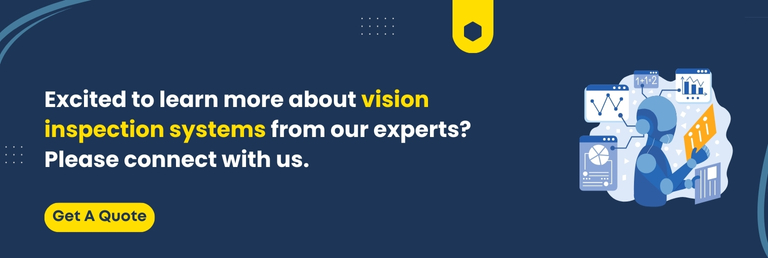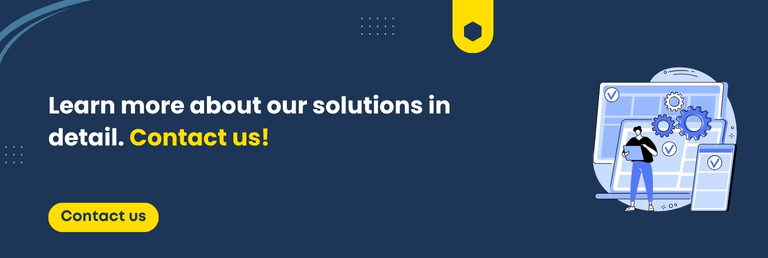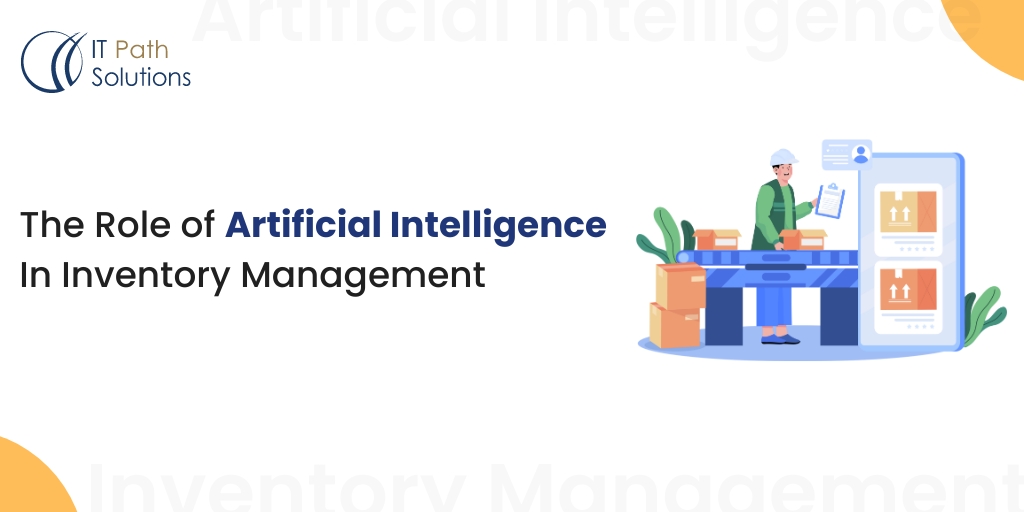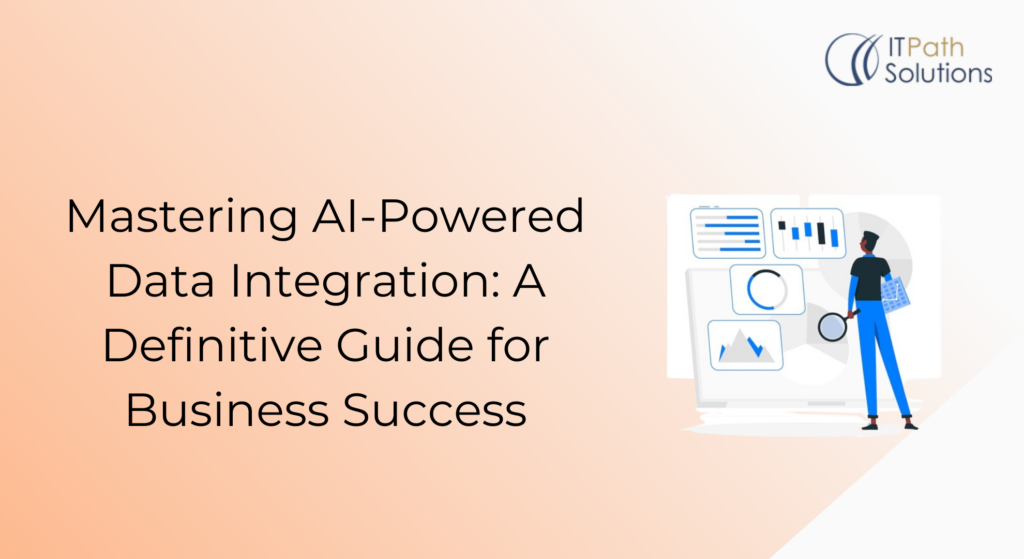Comprehensive Guide To Vision Inspection Systems in Manufacturing and Industrial Inspection
Artificial Intelligence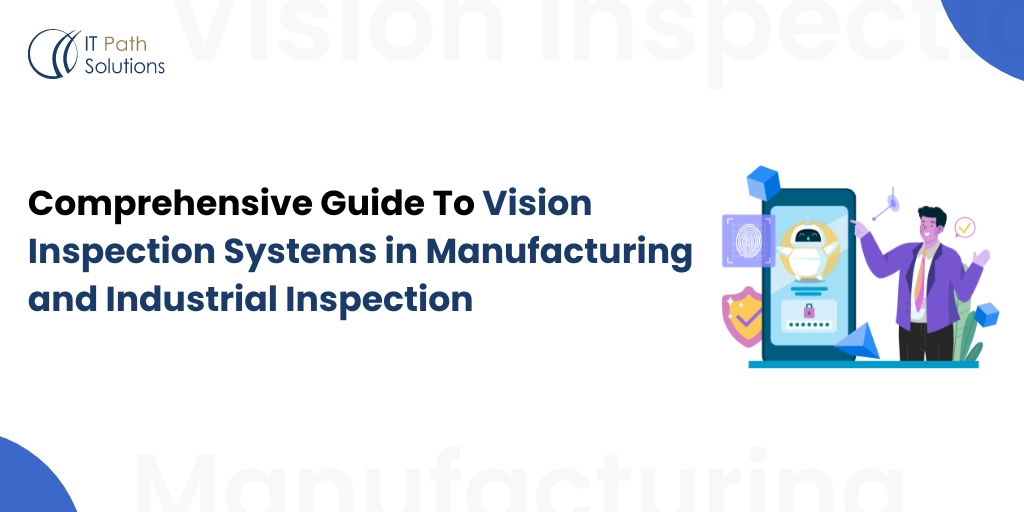
Increase efficiency, reduce waste, control your package quality, minimize rework, avoid recalls, and protect brand image—these are just a few of the endless benefits of using vision inspection in Manufacturing. In this blog, we will explore how leveraging these cutting-edge technologies can enhance the operations of the manufacturing system, ensuring that you consistently deliver top-quality products.
In this blog, we will discuss vision inspection, why it should be used, how it differs from manual inspection, and all other aspects.
To begin with,
What is a vision inspection system?
A vision inspection system includes an industrial camera, specialized lighting, lenses, and image processing software. This system captures images of products and checks them against predefined criteria, such as detecting defects, contaminants, misalignments, measurement inaccuracies, or missing parts.
By doing so, the system helps prevent defective products from going further down the supply chain.
This technology automates the inspection process, making the system more reliable, robust, and stable.
The use of vision systems in manufacturing increases the accuracy of the process and makes the entire system as perfect as possible.
What is the difference between a vision inspection system and a manual inspection?
We do not deny that manual inspection can be as powerful as a vision inspection system. However considering the huge amount of data collected and orders processed daily, handling all of this manually would be difficult and inefficient.
This is why there’s an urgent need for automated systems that go beyond manual inspection, providing faster and more reliable results.
Let’s explore how a vision inspection system outperforms manual inspection in key areas.
| Aspect | Vision inspection system | Manual Inspection |
| Less time to move past the production line
Imagine, if you are manufacturing 100 thousands of products, and each one of them needs to pass through quality checking parameters. You have a timeline of 15 days! |
With everything automated, from label checking to quality, the vision inspection system can deliver results in 15 days. | It is difficult to inspect within the decided timeframe with accuracy and perfectness. |
| Data Collection | It can quickly record and analyze tons of data to produce valuable reports | Processing the huge pile of data is difficult to achieve manually |
| Accuracy | Vision inspection systems are highly precise and capable of detecting minute defects | The human eye might miss catching minute defects in the product. |
| Flexibility | Vision inspection systems are less flexible and require reconfiguration if you want to shift to a different inspection type | Humans can quickly adapt to different inspection tasks |
The automation brought by a vision inspection system into the manufacturing process enhances the system’s flexibility and resilience. Implementing a vision inspection system offers several key benefits, including:
- Improved accuracy and consistency
- Increased speed and efficiency
- Cost savings and reduced human error
- Compliance with industry standards
Now, let’s move on to the next section, where we’ll discuss the different types of vision inspection systems.
Types of Vision Inspection:
There are six major types of inspections possible with a vision inspection system. We will discuss each one of them and see how they help in solving different purposes.
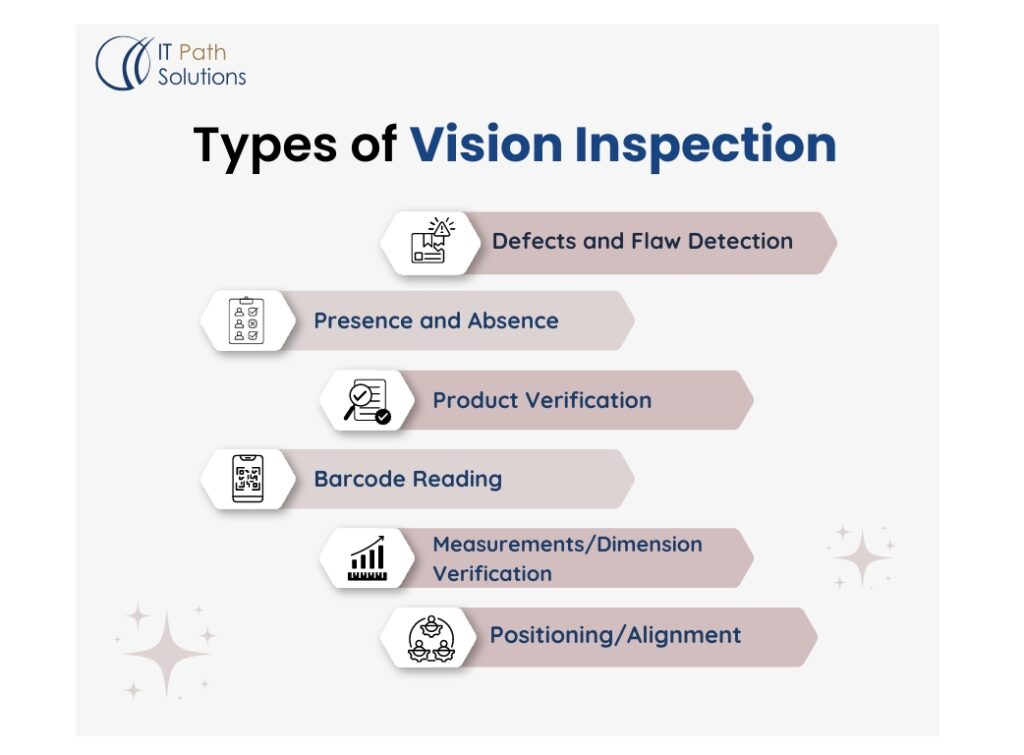
Defects and Flaw Detection:
Defects and flaw detection vision inspection systems go beyond the regular quality check and help in finding any defect on the product. This significantly improves the speed of the process and reduces the need for human intervention and errors.
A great example of its implementation is how a firm named Shelton, used a vision inspection system called WebSPECTOR to identify a product defect. As soon as the product passes through the production line, the system differentiates a defective product from a perfect one.
Presence and Absence:
Determining the quantity of products passing through the production line is an important aspect of manufacturing. A vision inspection system checks the number of products passing through the line and approves them as per the system criteria.
Suppose you want to ensure that a family chocolate box has 10 assorted chocolates in one box. The vision system cameras check the packaging of each one and notify if any of it is found missing.
Product verification:
The product verification system ensures that product labels are accurately matched with their corresponding products. This is particularly crucial in the pharmaceutical industry, where proper labeling is vital. Any misalignment can pose significant health risks, making it essential to design these systems with the utmost care and precision.
Barcode reading:
Advanced vision inspection systems can be used to identify machine codes and human-readable codes. The system reads the barcode, processes it, and lets it pass through the system.
With high speed and accuracy, it can process partially torn, damaged codes, or distorted images, and analyze them for no-reads or misreads.
Measurements/Dimension verification:
In production, verifying product measurements is often a critical factor. Vision inspection systems enable you to input precise product sizes and dimensions, ensuring that each product is accurately checked against these specifications.
For example:
In pharmaceutical product manufacturing, measurement/dimension verification is useful in checking the dimensions of the needles, their size, slant cut, etc. This helps ensure that the syringes of the right size and shape are dispatched to the medical practitioners.
Positioning/Alignment:
The positioning and alignment vision inspection system checks that the placement of the product is done correctly. For example, it checks whether the product is aligned front-faced or the lid is facing the cover of the box and other such parameters.
These applications of vision inspection systems help in process control, cost reduction, and reducing recalls.
Our Vision Inspection Solutions:
While the topic may be relatively new, we have successfully ventured into this vision inspection system and developed the following solutions.

Assembly Line Visualization:
Our Assembly Line Visualization System helps manufacturing companies track the number of products moving through the production line. It sends signals to relays, PLCs, and other sensors if any discrepancies are detected during the process.
This live monitoring system provides valuable insights for calculating production and packaging efficiency. It was indeed a success and our client appreciated how we delivered as per the expectations.
Defects Detection:
ITPath Solutions Defects Detection system is a type of vision inspection system that helps in identifying surface defects like scratches, dents, cracks, and corrosion. The defects detection vision system also checks for incorrect dimensions, misalignment, deformation, painting, and coating defects.
The client was very much impressed with the accuracy with which the system operated.
Size and Quantity Verification System:
Are you a bulk manufacturer and struggling with size and quantity verification issues? Worry not, our Size and Quantity verification verifies the number of items before the final packaging begins. This helps in ensuring that the right size and number of items go into the final packing of products.
We help you make sure that the exact amount of products goes into each packaging and that no item is missed out from the defined packaging items.
Label and Packaging defects detecting system:
We understood the struggle when a client approached us with the problem of finding it difficult to manage the label and packaging system manually. We helped them develop a label and packaging defect-detecting system. Our label and packaging defect vision inspection system checks for seal integrity issues, damaged packaging, and incorrect fill levels. It can also check for labeling defects such as Peeling, misprinting, half-printing, and missing labels. Etc.
Real-world Examples Of Using Vision Inspection Systems in Manufacturing:
Several leading brands have already started to experience significant advantages by incorporating vision inspection systems into their manufacturing operations.
These companies are leveraging the technology to enhance quality control, increase production efficiency, and reduce the risk of errors.
By automating inspection processes, they are not only improving product consistency but also cutting costs and ensuring compliance with industry standards. As a result, these brands are setting a new benchmark in their respective industries and gaining a competitive edge.
1. Hyundai:
Hyundai designed Elevate using CAD integrated with computer vision to facilitate faster prototyping.
2. Ford:
Ford, one of the biggest automobile manufacturers, integrated computer vision into 3D printers. This enhanced the inspection capabilities of the machines allowing them to build and deliver faster.
3. Foxconn Technology Group:
Foxconn introduced Foxconn NxVAE to inspect the 13 most common defects in manufacturing production lines. This ensures that the products passing through the line are delivered error-free.
4. Volvo’s Atlas computer vision:
Volvo Atlas employs over 20 cameras in their vision inspection system, detecting 40% more defects compared to manual inspection. The system operates with an average cycle time of 5-20 seconds, significantly faster than traditional inspection methods.
You can read more about real-world examples in this blog by Encord.
Emerging Trends In Vision Inspection System:
Businesses are increasingly adopting advanced technologies to improve their production lines, quality control measures, and overall operational efficiency. Here are some upcoming trends that are expected to shape the future of vision inspection systems.
AI and ML Integration:
The integration of AI and machine learning into vision inspection systems will significantly enhance their inspection capabilities. By using advanced algorithms and establishing optimal parameters, these systems can be trained to identify and categorize defects with greater precision, ultimately resulting in the optimization of the production process.
Miniature machine vision cameras:
The use of smaller cameras in manufacturing enables manufacturers to cover more areas of a unit by strategically placing multiple cameras in various locations. This cost reduction makes it possible for small to mid-sized businesses to utilize this advanced technology effectively, maximizing its benefits.
The rise of 3D vision inspection:
A 3D vision inspection system captures multiple images of a product as it moves along the production line, creating a comprehensive 3D model. By integrating these images, the system provides a detailed view of the product, enabling precise inspection. This technology is particularly valuable in the automotive industry, where 3D scans of connector pins help manufacturers reduce costs, minimize the risk of shipping defective components, and ensure higher quality control.
Conclusion:
We hope that this blog has helped you enhance your knowledge of vision inspection systems and their implementation in manufacturing. If you are considering using a vision inspection system in your business along with some advanced technologies, we can help you with the process. We have a team of experienced software developers who can get in touch with you and explain the process.
Frequently Asked Questions:
1. What are the benefits of using a vision inspection system?
Vision inspection system helps minimize quality errors, reduce human intervention, improve safety, speed up the product’s time to market, and deliver accurate results swiftly.
2. What are the main types of vision inspection systems?
Some of the primary types of vision inspection systems are:
- Line scan cameras;
- 1D vision systems;
- 2D vision systems;
- 3D vision systems;
- Vision guided robots;
- Image Inspection vision system.
3. What other technologies can one use along with a vision inspection system?
One can integrate Artificial Intelligence, Machine Learning, and Predictive analysis to enhance the capabilities of the vision inspection system. However, this is very subjective to the use of vision inspection systems.
4. How to find developers to integrate advanced technologies into the vision inspection system?
Well, if you are looking for developers who can help you integrate advanced technologies like AI and ML, we are happy to help! You can contact us for more information.
 Healthcare
Healthcare  Education
Education  Real Estate
Real Estate  Logistic
Logistic  Fitness
Fitness  Tourism
Tourism  Travel
Travel  Banking
Banking  Media
Media  E-commerce
E-commerce 